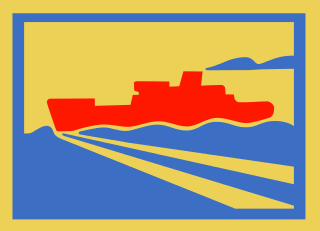
Operation Fortitude was the code name for a World War II military deception by the Allied nations as part of an overall deception strategy during the buildup to the 1944 Normandy landings. Fortitude was divided into two subplans, North and South, and had the aim of misleading the German High Command as to the location of the invasion.

Operation Bodyguard was the code name for a World War II deception strategy employed by the Allied states before the 1944 invasion of northwest Europe. Bodyguard set out an overall stratagem for misleading the Oberkommando der Wehrmacht as to the time and place of the invasion. Planning for Bodyguard was started in 1943 by the London Controlling Section, a department of the war cabinet. They produced a draft strategy, referred to as Plan Jael, which was presented to leaders at the Tehran Conference in late November and, despite scepticism due to the failure of earlier deception strategy, approved on 6 December 1943.

Operation Dragoon was the code name for the landing operation of the Allied invasion of Provence on 15 August 1944. Although initially designed to be executed in conjunction with Operation Overlord, the Allied landing in Normandy, a lack of available resources led to a cancellation of the second landing. By July 1944 the landing was reconsidered, as the clogged-up ports in Normandy did not have the capacity to adequately supply the Allied forces. Concurrently, the High Command of the French Liberation Army pushed for a revival of the operation that would include large numbers of French troops. As a result, the operation was finally approved in July to be executed in August.

The Normandy landings were the landing operations and associated airborne operations on Tuesday, 6 June 1944 of the Allied invasion of Normandy in Operation Overlord during World War II. Codenamed Operation Neptune and often referred to as D-Day, it was the largest seaborne invasion in history. The operation began the liberation of France and laid the foundations of the Allied victory on the Western Front.

Operation Avalanche was the codename for the Allied landings near the port of Salerno, executed on 9 September 1943, part of the Allied invasion of Italy during World War II. The Italians withdrew from the war the day before the invasion, but the Allies landed in an area defended by German troops. Planned under the name Top Hat, it was supported by the deception plan Operation Boardman.

Operation Copperhead was a small military deception operation run by the British during the Second World War. It formed part of Operation Bodyguard, the cover plan for the invasion of Normandy in 1944 and was intended to mislead German intelligence as to the location of General Bernard Montgomery. The operation was conceived by Dudley Clarke in early 1944 after he watched the film Five Graves to Cairo. Following the war M. E. Clifton James wrote a book about the operation, I Was Monty's Double. It was later adapted into a film, with James in the lead role.

Operation Ironside was a Second World War military deception undertaken by the Allies in 1944. It formed part of Operation Bodyguard, a broad strategic deception plan instigated by the Allies throughout the year to help cover the June 1944 invasion of Normandy. Ironside supported the overall deception by suggesting to the Germans that the Allies would subsequently land along the Bay of Biscay. It complemented efforts to deceive the Germans into believing that the Allies would also land in southern France at this time. Bordeaux was an important port for the German war effort and had already been a target of commando raids two years earlier. Ironside intended to play on German fears of an invasion in the region, with the aim of tying down defensive forces following Operation Overlord in June 1944.

Operation Titanic was a series of military deceptions carried out by the Allied Nations during the Second World War. They formed part of tactical element of Operation Bodyguard, the cover plan for the Normandy landings. Titanic was carried out on 5–6 June 1944 by the Royal Air Force and the Special Air Service. Its objective was to drop hundreds of dummy parachutists, noisemakers and small numbers of special forces troops in locations away from the real Normandy drop zones. It hoped to deceive the German defenders into believing that a large force had landed, drawing troops away from the beachheads and other strategic sites.

First United States Army Group was a fictitious Allied Army Group in World War II prior to D-Day, part of Operation Quicksilver, created to deceive the Germans about where the Allies would land in France. To attract Axis attention, prominent US general George S. Patton was placed in command of the fabricated formation.

The 80th Infantry (Reserve) Division was an infantry division of the British Army formed at the beginning of 1943, during the Second World War. For the twenty months that the division existed, it was a training formation. It was made responsible for providing final tactical and field training to soldiers who had already passed their initial training. After five additional weeks of training, the soldiers would be posted to fighting formations overseas. Notably, the division was used as a source of reinforcements for the 21st Army Group, which was fighting in Normandy. After all available troops left the United Kingdom for France, the division was disbanded.

Operation Overlord was the codename for the Battle of Normandy, the Allied operation that launched the successful invasion of German-occupied Western Europe during World War II. The operation was launched on 6 June 1944 (D-Day) with the Normandy landings. A 1,200-plane airborne assault preceded an amphibious assault involving more than 5,000 vessels. Nearly 160,000 troops crossed the English Channel on 6 June, and more than two million Allied troops were in France by the end of August.
Operation Cascade was the codename for an Allied military deception operation during the Western Desert Campaign of World War II for North Africa. Operation Cascade was one of the first successful Allied deception operations in World War II, and provided valuable experience for later operations.

Operations Taxable, Glimmer and Big Drum were tactical military deceptions conducted on 6 June 1944 in support of the Allied landings in Normandy. The operations formed the naval component of Operation Bodyguard, a wider series of tactical and strategic deceptions surrounding the invasion.
Ops (B) was an Allied military deception planning department, based in the United Kingdom, during the Second World War. It was set up under Colonel Jervis-Read in April 1943 as a department of Chief of Staff to the Supreme Allied Commander (COSSAC), an operational planning department with a focus on western Europe. That year, Allied high command had decided that the main Allied thrust would be in southern Europe, and Ops (B) was tasked with tying down German forces on the west coast in general, and drawing out the Luftwaffe in particular.
The 1st Special Air Service Brigade was a fictional brigade during the Second World War. It was first formed in Cairo in 1941, as part of a deception by Brigadier Dudley Clarke, to play on Italian fears of airborne attacks. Clarke used documents, photographs, news reports and even fake SAS soldiers to plant information about the brigade – he even named the Cairo-based deception department, 'A' Force, to bolster evidence of their existence.

Colonel John Henry "Johnny" Bevan was a British Army officer who, during the Second World War, made an important contribution to military deception, culminating in Operation Bodyguard, the plan to conceal the D-Day landings in Normandy. In civilian life he was a respected stockbroker in his father's firm.

Operation Royal Flush was a military deception employed by the Allied Nations during the Second World War as part of the strategic deception Operation Bodyguard. Royal Flush was a political deception that expanded on the efforts of another Bodyguard deception, Operation Graffham, by emphasising the threat to Norway. It also lent support to parts of Operation Zeppelin via subtle diplomatic overtures to Spain and Turkey. The idea was that information from these neutral countries would filter back to the Abwehr. Planned in April 1944 by Ronald Wingate, Royal Flush was executed throughout June by various Allied ambassadors to the neutral states. During implementation the plan was revised several times to be less extreme in its diplomatic demands. Information from neutral embassies was not well trusted by the Abwehr; as a result, Royal Flush had limited impact on German plans through 1944.

Operation Ferdinand was a military deception employed by the Allies during the Second World War. It formed part of Operation Bodyguard, a major strategic deception intended to misdirect and confuse German high command about Allied invasion plans during 1944. Ferdinand consisted of strategic and tactical deceptions intended to draw attention away from the Operation Dragoon landing areas in southern France by threatening an invasion of Genoa in Italy. Planned by Eugene Sweeney in June and July 1944 and operated until early September, it has been described as "quite the most successful of 'A' Force's strategic deceptions". It helped the Allies achieve complete tactical surprise in their landings and pinned down German troops in the Genoa region until late July.

Operation Rayon was a Allied deception operation in the Mediterranean Theatre during World War II. The operation called for Allied forces to mislead the Wehrmacht into believing that the Allies were going to attack the island of Crete. Operation Rayon was successful in its aims and forced the Germans to divert forces from other fronts to defend Crete and Occupied Greece. The operation was planned and implemented by Advanced Headquarters 'A' Force.











